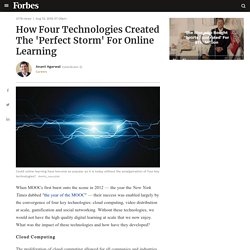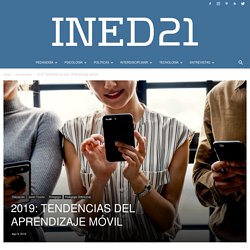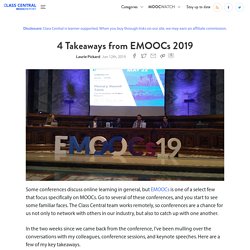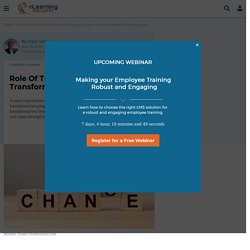

ELEMENTOS DE ELEARNING Y SU POSICIONAMIENTO CRÍTICO (Grainne Conole and Juan Domingo Farnós) Juan Domingo Farnos Grainne Conole El Marco donde se realiza el mismo Elearning que fue introducido a la lista de los principales factores que mas influyen en el aprendizaje a distancia/en línea (ELEARNING)

Holoniq. Distributed Learning Technologies and Next Generation E-Learning. How Four Technologies Created The 'Perfect Storm' For Online Learning. When MOOCs first burst onto the scene in 2012 — the year the New York Times dubbed "the year of the MOOC" — their success was enabled largely by the convergence of four key technologies: cloud computing, video distribution at scale, gamification and social networking.

Without these technologies, we would not have the high quality digital learning at scale that we now enjoy. What was the impact of these technologies and how have they developed? Cloud Computing The proliferation of cloud computing allowed for all companies and industries to scale exponentially, and online learning was no exception. It enabled online learning platforms to be responsive, fast and most importantly, to scale, thereby reaching anyone with an internet connection. Video Distribution at Scale Video sharing and distribution was coming into its prime just as MOOCs were starting to gain initial momentum, with the rise of YouTube and Vimeo allowing for easy distribution of high quality videos.
2019: TENDENCIAS DEL APRENDIZAJE MÓVIL. Hoy un infográfico que revela algunos datos que pueden ser de interés para las personas responsables de diseñar la instrucción y facilitar los procesos de aprendizaje de sus estudiantes (porque sin estudio no hay nada que hacer).

Traduzco el contenido del infográfico tomado de la fuente que se cita al pie del mismo. El 70% de los alumnos se sintió más motivado cuando entrenaba en un dispositivo móvil, en lugar de una computadora (Fuente: LearnDash). Los eLearners móviles suelen estudiar durante 40 minutos más que un estudiante que usa una computadora de escritorio o una tableta. (Fuente: MNAlearning.) Claramente, el aprendizaje móvil es «imprescindible» hoy. Dos métodos de aula invertida: el más utilizado y el más avanzado. En 4 minutos. Learning Engineering: A Caliper Example - In my recent IMS update post, I wrote, [T]he nature and challenges of interoperability our sector will be facing in the next decade are fundamentally different from the ones that we faced in the last one.

Up until now, we have primarily been concerned with synchronizing administration-related bits across applications. Which people are in this class? Are they students or instructors? What grades did they get on which assignments? I then asserted the following positions: Because learning processes are not directly observable, blindly running machine learning algorithms against the click streams in our learning platforms will probably not teach us much about learning.On the other hand, if our analytics are theory-driven, i.e., if we start with some empirically grounded hypotheses about learning processes and design our analytics to search for data that either support or disprove those hypotheses, then we might actually get somewhere. A Look at the Future of Open Educational Resources. Student data privacy in MOOCs: a sentiment analysis: Distance Education: Vol 0, No 0.
From technology enhanced learning to technology enhanced learner. 4 Takeaways from EMOOCs 2019 — Class Central. Some conferences discuss online learning in general, but EMOOCs is one of a select few that focus specifically on MOOCs.

Go to several of these conferences, and you start to see some familiar faces. The Class Central team works remotely, so conferences are a chance for us not only to network with others in our industry, but also to catch up with one another. In the two weeks since we came back from the conference, I’ve been mulling over the conversations with my colleagues, conference sessions, and keynote speeches. Here are a few of my key takeaways. MOOC platforms converge The conference featured keynotes from the CEOs of edX and FutureLearn, Anant Agarwal and Simon Nelson respectively, and the Chief Content Officer of Coursera, Dil Sidhu.
MOOC platforms have also converged on a common business model, as described in Dhawal Shah’s Six Tiers of MOOC Monetization. Evaluación de cursos en línea desde la perspectiva del estudiante: un análisis de métodos mixtos. Role Of Training In System Transformation/Change Programs. When a company or organization undertakes any sort of major change, it is viewed differently by different users.

For some, it is exciting, for others it is threatening. One of the questions that contribute to creating the threatening mood in users is: "Will I be able to cope with the new processes and technology and be productive in the new environment? " This question offers a clear signal to the need for a well-planned training program for all impacted users/workforce. What can be fulfilled by training?
Now, to be frank, let’s not believe that a training program alone can fulfill all these expectations. A training program is surely the answer to help the workforce acquire new knowledge/skills, understand new ways of working, adapt to new systems, processes, and practices, alter behavior, and be productive from day one in the new environment. Role Of Training. Vol. 21, Núm. 1 (2018) Artículo. Estar informado (semanal 11/5/2019) La educación del futuro: conoce las tendencias más prometedoras.